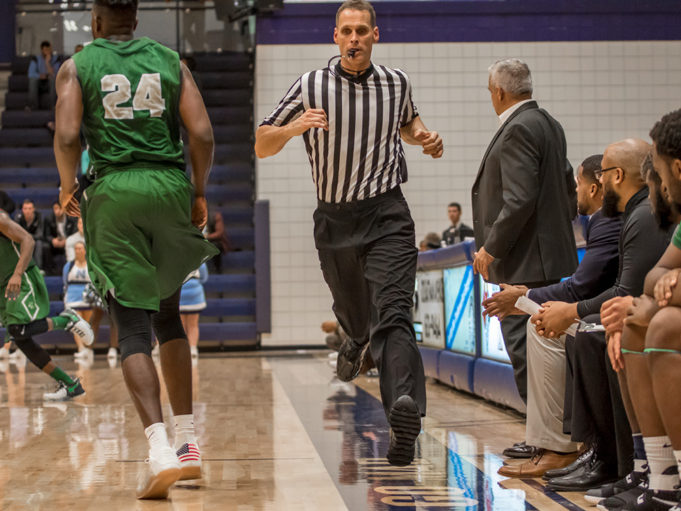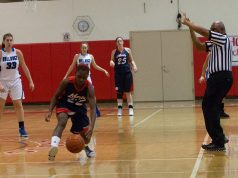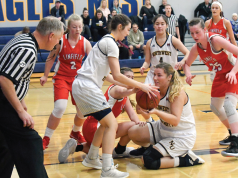There is more to know than just foul or violation. Commonly astute officials might have heard once to have an awareness to what type of offense and defense each team is using. All of which is good, but officials can go deeper with more knowledge about the game and how it changes every few minutes. Two of those deeper understandings are picking up on the personality of each game and the substitution patterns. Knowing each separates the good from the great.
Game Personality Awareness
We know that individual games have their own personalities. There are conference rivalries, non-conference rivalries, blowout games, games where every possession matters, games that are very chippy, etc. Going into the game, it is helpful to have a sense of what personality the game may take beforehand. If not, you have to identify the game’s personality right away.
For example, Xavier and Cincinnati is an intense rivalry. The crosstown teams know each other, given the universities are within a few miles of each other. Often in these types of match-ups, the game will have started before it actually starts — social media can be used beforehand to stew emotions. In these games, officials need to be aware of dead-ball situations and an increased likelihood for unsporting behavior.
Conversely, you may be involved in game that is going really well with everyone behaving very sportingly. Then out of the blue someone gets a little excitable on the bench. In those cases it may not be beneficial to immediately issue a technical foul.
In either situation, officials need to know the personality of the game and be aware of the context of the game so they understand when something is out of character for the game. Lacking an understanding of the context of a game and adding fuel to a fire with a technical foul will not help the game. It wakes everyone up and can make the game more challenging for the crew.
Substitution Awareness
As the game goes on, dig deeper to figure out why a substitute is coming in the game. Some reasons a substitute may be coming into the game include: to shoot threes, block shots, play defense, disrupt, give or take a foul, playing time, etc.
Every time a substitution occurs, ask yourself why. Sometimes it may be that the player is in foul trouble. Or it may be the team’s normal substitution pattern for that player to get a rest.
However, be aware of abnormal situations. When a starter leaves the game three minutes into the first quarter (or half) with no fouls, a red flag should go up in your mind.
Throughout the game, be aware of the normal substitution patterns of the teams. Awareness of patterns can allow a better understanding of what may be required of you and your coverage. Know each team’s first player off the bench. Who is the team’s spark plug? Who is the team’s post presence?
Some substitutions to look for:
- First substitute into the game.
- Player goes out for foul trouble.
- Impact substitutions.
- First substitute of second half.
- Post player gets substituted with no foul trouble.
The team’s stats help to provide likely scenarios for who and what those players may be. Past experience with a team can also be helpful. In a pregame, discuss who has had the teams before and what they picked up from that previous experience. Who is the key scorer, the key defender, the key substitute, etc. Additionally, know the makeup of the players’ personalities. Is a certain player going to be someone who has a calm head and can be used as an ally or is a player going to be someone who has a hot head and may need more awareness?
Take a situation where a team quickly gets behind, 14-0, and the coach substitutes all five players. Be aware of the psychological makeup of the entire team following that type of substitution. The team may be upset and become increasingly frustrated. No player enjoys being taken out of a game, especially after falling quickly behind. Further, the coach may take the team’s struggles out on the crew. Those are all important context situations for the crew to be aware of and to aid them in carrying out their duties.
A significant substitution situation that crews must pick up on is when a team substitutes out a post player who is not in foul trouble. The team may be trying to pick up the pace of the game, to start running or to start pressing.
Another possibility is the player is a team’s sixth player who is good enough to start but is used as a spark plug off the bench. That can be picked up when you have had a team before.
Others, like former North Carolina coach Dean Smith, played their entire bench in the first half. Coach Smith was believed to have done that to get meaningful experience out of players and to wear the other team down.
Be sure to monitor the beginning and end of the substitution process. Not having the appropriate number of players on the court after a substitution can rear its ugly head for officials. Each crewmember is wise to count the players before resuming play, whether that is a substitution, timeout, quarter break or halftime intermission.
Further, you must know the substitution rules. When a player is replaced, he or she cannot re-enter until the clock has legally started and time has gone off the clock. In order to correctly officiate, know who was subbing in and who the substitutes are.
There is more to awareness than properly judging fouls and violations.
What's Your Call? Leave a Comment:
Note: This article is archival in nature. Rules, interpretations, mechanics, philosophies and other information may or may not be correct for the current year.
This article is the copyright of ©Referee Enterprises, Inc., and may not be republished in whole or in part online, in print or in any capacity without expressed written permission from Referee. The article is made available for educational use by individuals.



















